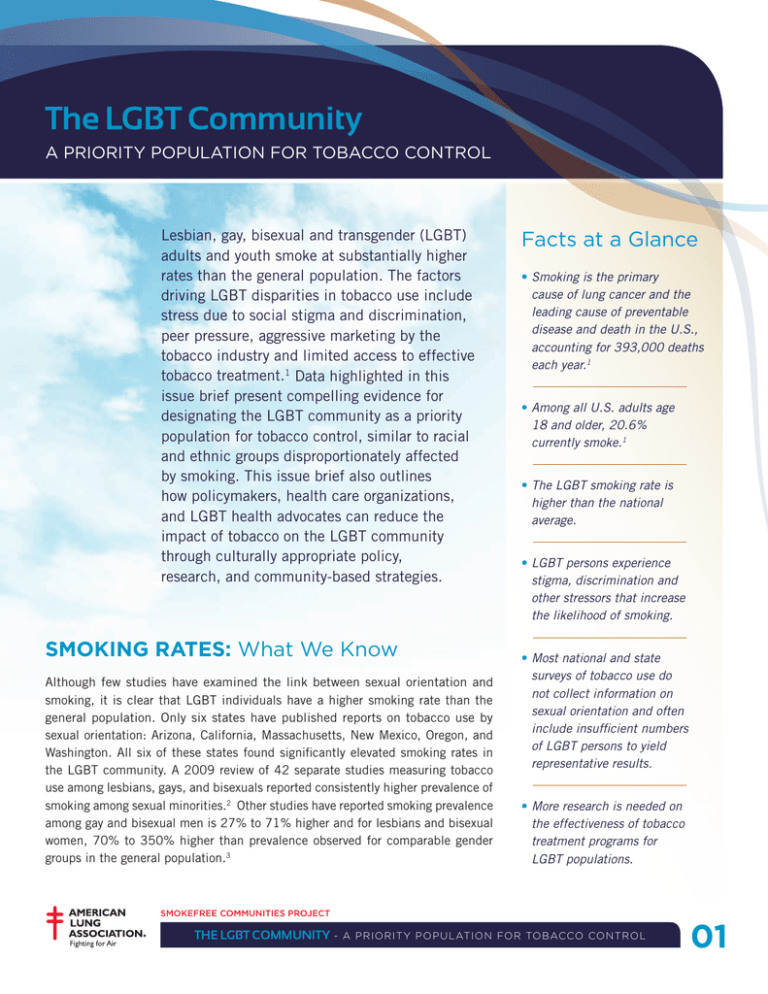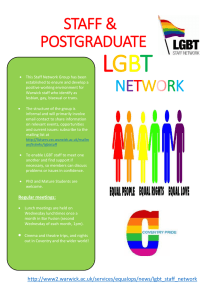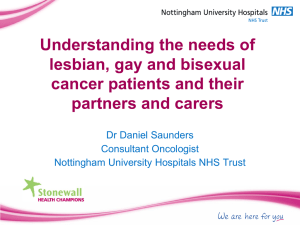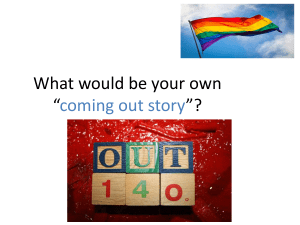
The LGBT Community
A Priority Population For Tobacco Control
Lesbian, gay, bisexual and transgender (LGBT)
adults and youth smoke at substantially higher
rates than the general population. The factors
driving LGBT disparities in tobacco use include
stress due to social stigma and discrimination,
peer pressure, aggressive marketing by the
tobacco industry and limited access to effective
tobacco treatment.1 Data highlighted in this
issue brief present compelling evidence for
designating the LGBT community as a priority
population for tobacco control, similar to racial
and ethnic groups disproportionately affected
by smoking. This issue brief also outlines
how policymakers, health care organizations,
and LGBT health advocates can reduce the
impact of tobacco on the LGBT community
through culturally appropriate policy,
research, and community-based strategies.
Smoking Rates: What We Know
Although few studies have examined the link between sexual orientation and
smoking, it is clear that LGBT individuals have a higher smoking rate than the
general population. Only six states have published reports on tobacco use by
sexual orientation: Arizona, California, Massachusetts, New Mexico, Oregon, and
Washington. All six of these states found significantly elevated smoking rates in
the LGBT community. A 2009 review of 42 separate studies measuring tobacco
use among lesbians, gays, and bisexuals reported consistently higher prevalence of
smoking among sexual minorities.2 Other studies have reported smoking prevalence
among gay and bisexual men is 27% to 71% higher and for lesbians and bisexual
women, 70% to 350% higher than prevalence observed for comparable gender
groups in the general population.3
Facts at a Glance
•S
moking is the primary
cause of lung cancer and the
leading cause of preventable
disease and death in the U.S.,
accounting for 393,000 deaths
each year.1
•A
mong all U.S. adults age
18 and older, 20.6%
currently smoke.1
•T
he LGBT smoking rate is
higher than the national
average.
•L
GBT persons experience
stigma, discrimination and
other stressors that increase
the likelihood of smoking.
•M
ost national and state
surveys of tobacco use do
not collect information on
sexual orientation and often
include insufficient numbers
of LGBT persons to yield
representative results.
•M
ore research is needed on
the effectiveness of tobacco
treatment programs for
LGBT populations.
Smokefree Communities Project
THE LGBT COMMUNITY
- A PRIORITY POPULATION FOR TOBACCO CONTROL
01
Adults
Smoking Prevalence In Adults By State
On the whole, bisexual men and
women appear to have the highest
smoking rates of any subgroup for
which data is readily available.
31%
ARIZONA
•F
or all of the state surveys that
collected data on bisexuals,
smoking rates for this group was
higher than 30 percent, peaking
at a high of 39.1 percent.4,5,6,7,8,9
•A
mong bisexual women, the
odds of smoking ranged from 1.5
to 3.5 higher than for straight
women. Lesbians had between
1.2 and 2.0 times the odds of
smoking compared to straight
women. The odds of smoking for
bisexual men were 0.9 to 2.6,
when compared to straight men.
Compared to straight men, gay
men have between 1.1 and 2.4
times the odds of smoking.5
•V
ery little data are available by
racial and ethnic background.
One study that looked at gay and
bisexual men together found
elevated smoking rates among
whites and Hispanics, but not
among Native Americans or
Asian/Pacific Islanders.10
Almost no information exists on
smoking rates among transgender
people. However, this population is
considered especially vulnerable given
their high rates of substance abuse,
depression, HIV infection, and social
and employment discrimination, all of
which are characteristics associated
with higher smoking prevalence in
the general population.11 The 2004
California Tobacco Use Survey found
that about 2 percent of all LGBT
adults identify as transgender. At 30.7
percent, their smoking prevalence was
very close to the overall LGBT rate of
30.4 percent.12
MEN
22%
36%
18%
CALIFORNIA
WOMEN
29.5%
26.5%
19%
30.9%
22.3%
11.5%
MEN
WOMEN
34.2%
28.8%
ILLINOIS
18.9%
38.8%
30.9%
MASSACHUSETTS
20.6%
39.1%
NEW MEXICO
27.2%
22%
WASHINGTON
38.7%
29.5%
19.2%
16.6%
LEGEND
Straight
38.1%
29.8%
LGBT
Bisexual
MEN
WOMEN
Lesbian/Gay
Sources: Arizona Tobacco Survey, 2002 & 2005, Massachusetts BRFSS, ages 18-64, 2001-2006, New Mexico
BRFSS, ages 18-64, 2005-2008, Illinois Adult Tobacco Survey, 2003 & later, California Health Interview Survey
2005 & 2007, Washington BRFSS, 2003-2006
Smokefree Communities Project
THE LGBT COMMUNITY
- A PRIORITY POPULATION FOR TOBACCO CONTROL
02
Youth
Smoking Prevalence In Youth
38.7%
LEGEND
LGBT
5.7%
15.9%
Until more national and state tobacco
use surveys include questions about
sexual orientation and gender identity,
the research and public health
community has to rely primarily on
information collected by smaller, often
localized studies. Small numbers
of participants, as well as regional
differences, can yield results that may
not be representative of the nation at
large. In addition, significant findings
about smaller subsets of the study
population, including transgender
individuals and LGBT people of color,
can be missed if too few participants
were included in the study.15
4.3%
• In a study of 10,685 adolescents
living throughout the U.S.,
researchers found that compared
to heterosexuals, “mostly
heterosexual” girls were 2.5
times more likely, and lesbian/
bisexual girls were an alarming
9.7 times more likely to smoke
at least weekly. Boys identified
as “mostly heterosexual” were
2.5 times more likely than
heterosexual boys to smoke at
least weekly, but gay/bisexual
boys were no more likely to
smoke than heterosexual boys.14
16 YEAR OLD BOYS
10.2%
• In a large study of multiple
behavioral risk factors, bisexual
boys were twice as likely to
smoke regularly as either gay
or straight boys. Exclusively
homosexual (gay) boys and
girls did not differ significantly
from their straight counterparts
in their likelihood of smoking
regularly.13
9.8%
16 YEAR OLD girls
Estimates of smoking prevalence
among LGBT youth range from 38%
to 59%, compared to a prevalence
rate of 28% to 35% for the total
youth population, according to the
2009 review.2
Mostly Heterosexual
Straight
Data represents % of study respondents who reported smoking at least weekly. Not all responses included sexual
orientation, so percentages do not add up to 100. Source: Austin et al, 2004
Smokefree Communities Project
THE LGBT COMMUNITY
- A PRIORITY POPULATION FOR TOBACCO CONTROL
03
CONTRIBUTING FACTORS
Young people are especially susceptible to smoking. Indeed, the vast majority of smokers start
smoking before the age of 21. While LGBT people face the same pressures to smoke as the general
population, LGBT individuals are at risk for a number of additional reasons including:
Stigma and Discrimination
LGBT populations often experience high stress due to marginalization and discrimination in personal
interactions and in society at large. Actual or even perceived stigma causes stress, and research
has shown that smoking rates, as well as other negative health behaviors and outcomes are higher
in groups that experience high levels of stress.16 Among LGBT youth, stress due to homelessness,
coming out at an early age, rejection by family and peers and discrimination are among the most
frequently cited reasons for smoking.17
Social Bonding and the Bar Culture
LGBT people in some areas have limited opportunities to interact with peers outside of smoking
venues.18 Historically, bars were among the few safe spaces for LGBT people, and they have played an
important social role in the LGBT community for many decades.
Lack of Access to Quality Treatment and Care
Individuals in same-sex relationships are significantly less likely to have health insurance than those in
opposite-sex relationships.19 Additionally, in one study, LGBT participants were twice as likely to report
being denied or given inferior medical care as their straight counterparts.20
Targeting by the Tobacco Industry
The tobacco industry aggressively targets LGBT audiences for advertising. Tobacco advertisements in
gay and lesbian publications often depict tobacco use as a “normal” part of LGBT life. According to
a 2005 study, 30% of non-tobacco advertisements in LGBT publications, such as those that promote
entertainment products and venues, sexual services, clothing, and even rehab programs—feature
tobacco use.21
Acceptance of the Status Quo by LGBT Advocacy Organizations
Many leaders of LGBT organizations do not view tobacco control as a priority health issue. In
interviews with 74 LGBT leaders, some expressed the opinion that drinking and smoking were central
to the coming out process for many people. While leaders recognized that smoking is dangerous to
one’s health, some also noted that combating smoking could jeopardize tobacco industry funding to
their organizations.22
Promising Intervention: The Last Drag
Created by the Coalition of Lavender Americans on Smoking and Health, The Last Drag has been offered in
several cities throughout California and around the country. The Last Drag provides a safe space for LGBT
smokers to go through the quitting process in a supportive group environment. A 2007 report on The Last
Drag classes in San Francisco showed among those who completed the program, 85 percent were able to
quit smoking. Six months after the program ended, 55 percent of those contacted were still smokefree.24
Smokefree Communities Project
THE LGBT COMMUNITY
- A PRIORITY POPULATION FOR TOBACCO CONTROL
04
MOVING FORWARD
Policy And Environmental Change Protects Everyone
Research demonstrates that a comprehensive approach works best: a combination of policy change,
prevention messaging campaigns targeted to vulnerable populations, and tobacco cessation services.
The American Lung Association calls on governmental agencies, healthcare systems, LGBT health
advocates, and community members to work together to take the following actions:
01
Support Evidence-Based Tobacco Control Policies
Interventions targeting priority populations including the LGBT community are more likely to succeed
when communities adopt proven tobacco control policies, such as higher taxes on cigarettes and other
tobacco products, prohibiting smoking in all public spaces and workplaces and coverage for tobacco
cessation programs by both public and private health insurance plans.
02
Recognize LGBT Communities as a Priority Population
Public and private funders should recognize LGBT communities as a priority population for tobacco
prevention and cessation services. Funding should be provided to encourage the research community
to evaluate promising innovations and interventions to prevent tobacco use and to promote quitting in
LGBT communities.
03
Collect Data on Sexual Orientation and Gender Identity in Health Studies
and Tobacco Cessation Programs
The Centers for Disease Control and Prevention (CDC) and all state Departments of Health should
include sexual orientation and gender identity questions in the core demographic questions of state
and national public health surveillance systems such as the National Health Interview Survey (NHIS)
and the Behavioral Risk Factor Surveillance Survey (BRFSS). Smoking cessation programs including
members of The North American Quitline Consortium (NAQC) should include sexual orientation as a
standardized core demographic question during intake.
04
Ensure LGBT Cultural Competency in Tobacco Control Planning
and Cessation Programs
State, local, and health care systems’ tobacco control programs should include representatives from
LGBT organizations in disparity reduction planning and intervention development and should ensure
prevention and cessation program staff and volunteers are culturally competent and able to effectively
serve the LGBT community.
05
Consider Alternative Funding Sources
To effectively advocate on behalf of LGBT communities, LGBT advocacy organizations should identify
alternative funding sources to tobacco industry sponsorship. Tobacco companies have been known
to offer funding to groups contingent on those groups using their cessation interventions. Industrycreated interventions have been proven ineffective at best, and some have been shown to actually
increase youth susceptibility to smoking.
Conclusions
In spite of the progress that has been made on tobacco control in the United States, smoking
continues to claim lives and rob millions of their health. To develop an effective public health
response to smoking in lesbian, gay, bisexual and transgender communities, more data is
urgently needed about the impact of smoking on these groups. By focusing on the challenges and
recommendations highlighted in this issue brief, communities can make significant strides in
improving the health of their LGBT populations.
Smokefree Communities Project
THE LGBT COMMUNITY
- A PRIORITY POPULATION FOR TOBACCO CONTROL
05
References
Ryan H, et al. Smoking among lesbians, gays and bisexuals: a review of the literature.
American Journal of Prevention Medicine. 2001; 21:142-149; Centers for Disease Control and Prevention. National
Center for Health Statistics. National Health Interview Survey Raw Data, 2008. Analysis performed by the American
Lung Association Research and Program Services Division using SPSS and SUDAAN software.
1
Lee JG, Griffin GK and Melvin CL. Tobacco use among sexual minorities in the USA, 1987 to May 2007:
A systematic review. Tobacco Control. 2009;18:275-282.
2
Burkhalter J, et al. Intention to quit smoking among lesbian, gay, bisexual, and transgender smokers.
Nicotine & Tobacco Research, 2009; 11(11):1312-1320.
3
California Health Interview Survey. 2005 & 2007, UCLA Center for Health Policy Research.
4
Behavior Risk Factor Surveillance System (BRFSS). 2003-2006, Center for Health Statistics, Washington State
Department of Health. Available online: www.doh.wa.gov/ehsphl/chs/chsdata/brfss/BRFSS_tables.htm.
5
Tobacco Use and Interventions Among Arizona Lesbian, Gay, Bisexual and Transgender People. 2006, Arizona
Department of Health Services. Available online: www.tobaccofreearizona.com/reports/pdf/05_lgbt-survey.pdf.
6
Query Builder for New Mexico’s Behavioral Risk Factor Surveillance System (BRFSS) Data. 2005- 2008, New Mexico’s
Indicator-Based Information System (NM-IBIS), New Mexico Department of Health. Available online: http://ibis.health.
state.nm.us/query/builder/brfss/BRFSSAgeAdj/BMIAgeAdj.html
7
Behavior Risk Factor Surveillance System (BRFSS). 2001-2006, Health Survey Program, Massachusetts Department of
Public Health. Available online: www.mass.gov/dph/hsp.
8
Adult Tobacco Survey: Illinois. 2003 and later, Illinois Department of Public Health. Available online:
www.gaydata.org/02_Data_Sources/ds010_ATS/Illinois/ds010_ATS_IL.html.
9
Stall R D, et al. Cigarette smoking among gay and bisexual men. American Journal of Public Health.
1999;89(12):1875-1878.
10 California Lesbians, Gays, Bisexuals and Transgender Tobacco Use Survey. 2004, California Department of Health
Services Tobacco Control Section.
11 Udry J R and Chantala, K. Risk assessment of adolescents with same-sex relationships.
Journal of Adolescent Health. 2002;31(1): 84-94.
12 Austin S B, et al. Sexual orientation and tobacco use in a cohort study of US adolescent girls and boys. Archives of
Pediatrics & Adolescent Medicine. 2004;158:317-322.
13 Lesbians, Gays, Bisexuals, and Transgenders of Color Sampling Methodology: Strategies for Collecting Data in Small,
Hidden, or Hard-to-Reach Groups to Reduce Tobacco-Related Health Disparities. 2009, Tobacco Research Network on
Disparities (TReND), National Cancer Institute. Available online: http://cancercontrol.cancer.gov/tcrb/trend/lgbt/docs/
LGBTReport508.pdf.
14 Health Care Needs of Gay Men and Lesbians in the United States. Council Report. Journal of the American Medical
Association. 1996;275(17):1254-1359.
15 Ryan C, et al. Family rejection as a predictor of negative health outcomes in white and Latino lesbian, gay,
and bisexual young adults. Pediatrics; 2009;123(1):346-352.
16 Remafedi G. Lesbian, gay, bisexual, and transgender youths: who smokes, and why? Nicotine Tobacco
Research.2007;9(Suppl 1):S65-S71.
17 Buchmueller T and Carpenter CS. Disparities in health insurance coverage, access, and outcomes for individuals in
same-sex versus different-sex relationships, 2000-2007. American Journal of Public Health. 2010;100:489-495.
18 Mays V and Cochran S. Mental health correlates of perceived discrimination among lesbian, gay, and bisexual adults in
the United States. American Journal of Public Health. 2001;91(11): 1869-76.
19 Smith EA, Offen N and Malone RE. What makes an ad a cigarette ad? Commercial tobacco imagery in the lesbian, gay
and bisexual press. Journal of Epidemiology & Community Health. 2005;59:1086-1091.
20 Offen N, Smith EA and Malone RE. Is Tobacco a Gay Issue? Interviews with leaders of the lesbian, gay, bisexual and
transgender community. Culture, Health, and Sexuality. 2008; 10(2):143-157.
21 Tesler L. and Malone R. Ethical Conduct in Public and Private Arenas. American Journal of Public Health.
2008;98(12):2123-2133.
22 Wakefield M. et al. Effect of televised, tobacco company-funded smoking prevention advertising on youth smoking-
23 related beliefs, intentions and behavior. American Journal of Public Health. 2006;96(12):2154–2160.
Gordon B and Soliz G. The Last Drag: Final Report July 2005-June 2007. Coalition of Lavender Americans on
Smoking & Health. June 29, 2007.
24 www.lung.org
Smokefree Communities Project Paid for with funds provided from the U.S. Department of Health and Human Services
THE LGBT COMMUNITY
- A PRIORITY POPULATION FOR TOBACCO CONTROL
06



